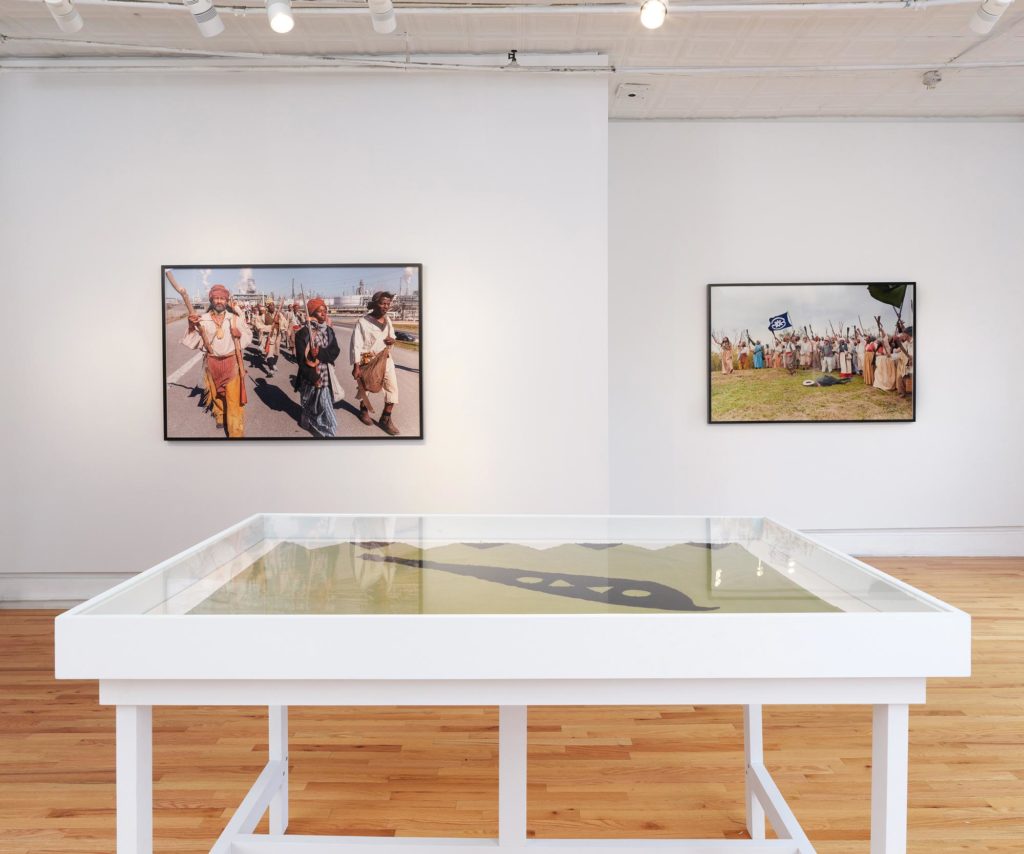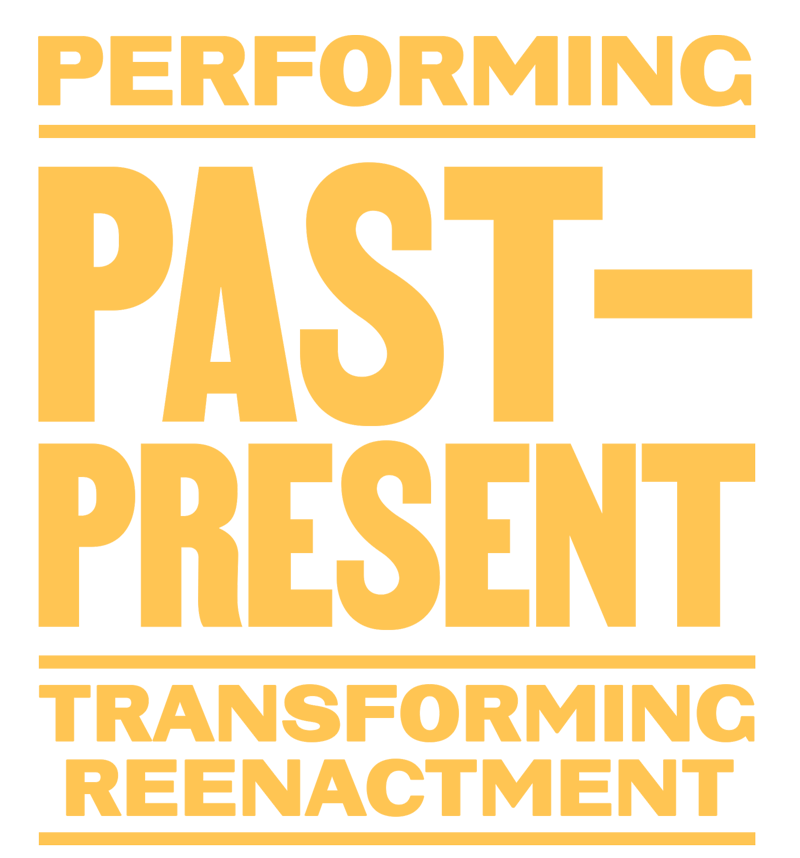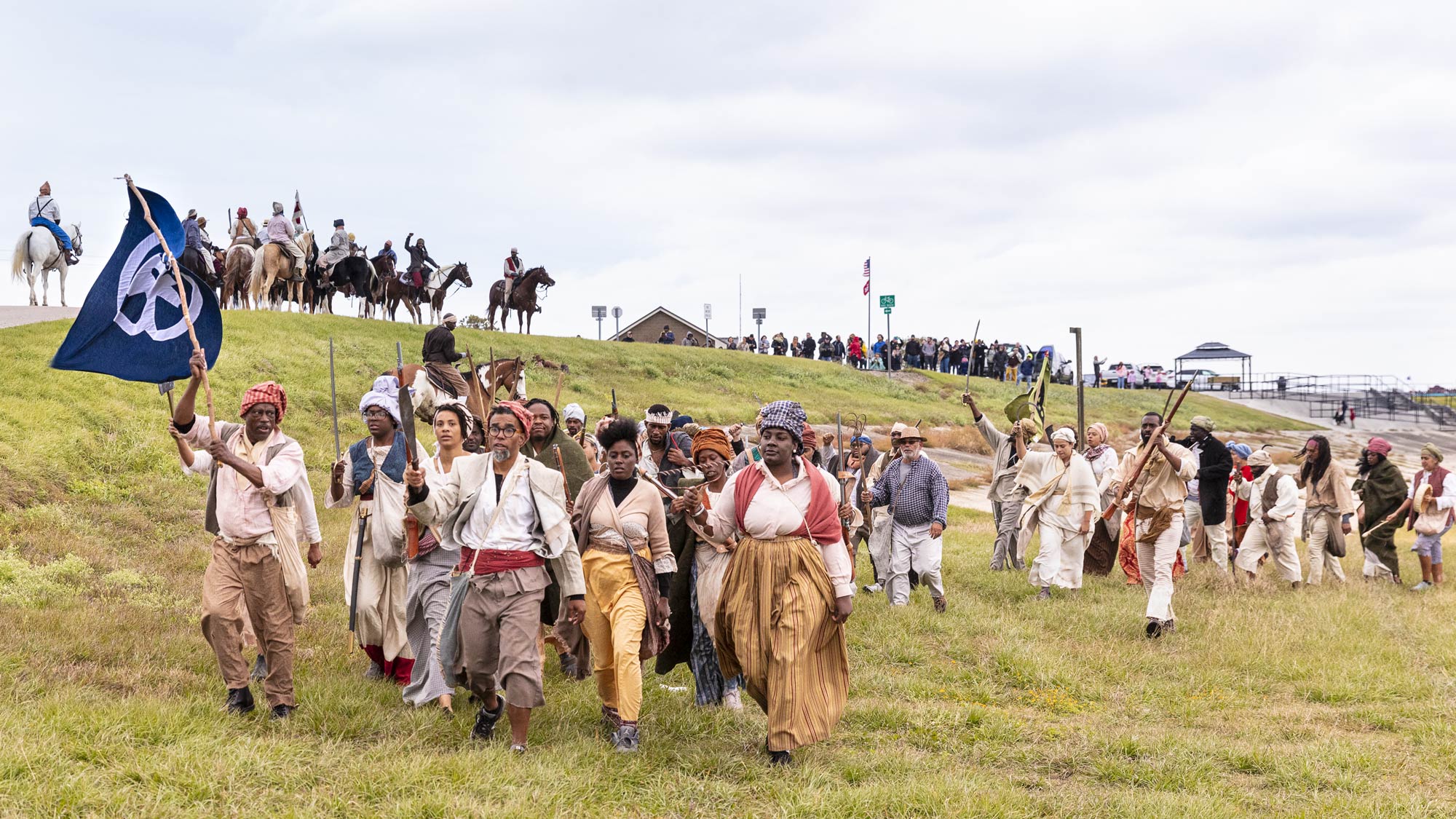New Orleans
November 8–9, 2019
Slave rebellions were a continuous source of fear in the American South, especially since black slaves accounted for more than
one-third of the region’s population in the 18th century.1
So begins the most current history.com article on slave rebellions. The writers can imagine a fear of rebellion but not the hopes embodied therein; they traffic in an actuarial metaphor, “accounting,” that subtly affirms that “black slaves” were indeed commodities; and they proffer a unit, “the American South,” that includes the slavers and their enablers but not the enslaved, whose resistance to slavery is just as Southern as slavery, perhaps more so.
Directly at this white-out of blackness, history, and rebellion, artist Dread Scott aims his Slave Rebellion Reenactment. With the support of New Orleans-based Antenna Works2 and funding from many non-profits and individuals, Scott—whose chosen name promises other futures to his famously wronged namesake, Dred Scott—reenacted the 1811 German Coast Uprising, the largest slave revolt in US history. And for the panoply of images of enslaved bodies that already circulate—images of jolly docility, of dignified forbearance, of obliterative degradation, of headlong flight—Scott substitutes images of rebellious black bodies: an armed, disciplined, conspiratorial mass led by Charles Deslondes, Kook, Quamana, Jeesamine, and Maria Rose, and others,3 an army of now palpable ancestors who bequeath armed struggle and a vision of just action even more radical than that of America’s enslaver founders.
For two days Scott and approximately 500 performers, some on horseback, all carrying weapons, all dressed in handmade period costumes, reenacted the Uprising, beginning on November 9th 2019 where the uprising did, in La Place, Louisiana, 30 miles west of New Orleans and concluding the following day in the French Quarter. The 1811 Uprising was brutally suppressed: the rebels were defeated; most fled, many were captured and dismembered, their heads set on pikes. Prizing speculative history over fidelity, the 2019 reenactment skirted defeat, marching through industrial sprawl and petrochemically sodden spaces, through so-called Cancer Alley, and into New Orleans, where Scott’s army occupied the streets of the Quarter, chanting “No More chains! Freedom!”
I attended both days of the reenactment, moving with the crowds, sometimes running alongside the procession, making images—along with the many journalists, affiliated friends and family members, and film crews, including Scott’s, helmed by acclaimed filmmaker John Akomfrah. Akomfrah’s technical apparatus enveloped the reenactment; several electric tracking vehicles with gyroscopically stabilized jib arms bearing 6K cameras led the procession, framing the approach of Scott and other leaders in the front lines. A drone with yet another camera flew above, a pestering fly and buzzing angel. Not only did Akomfrah’s crew have access to the entirety of the reenactment, the reenactment forthrightly addressed them, was made for and with their cameras. A few non-public events along the way, such as the reenactment of the attack on the slaver Manuel Andry, were only open to registered media outlets, most of whom could witness from a distance while the official crew documented. On the other hand, the reenactment of the battle that ended the 1811 Uprising but only punctuated the 2020 edition, was public; it was attended by a few hundred people, all of whom were required to watch from a berm overlooking the vast Bonnet Carré Spillway, while the official crew took up positions on either side of the skirmish, Akomfrah directing via two-way radios.
Thus did 18th c. garb and gear mix with 21st c. staging and media equipment: in the hands of artists, journalists, witnesses, and some of the reenactors themselves, who selfied and insta-ed their compatriots. Most of those reporting on the reenactment struggled to make images that framed out other photographers or excluded signs of contemporaneity; during breaks the pros and amateurs pulled individual reenactors away from the mass to make portraits against “neutral” backgrounds of foliage and fields. Those who sought to buoy the fiction of the “historical” by isolating the reenactors from the tech, from levees and industry and street signs and roadside restaurants, missed some of Scott’s point: he and his reenactors are the time travelers, not us. But we aren’t so much witnesses to their jarring arrival as they are a challenge to our endless brutalities: to the land, to each other, to Black and Indigenous peoples, to their frozen images.


Attuned to the reenactors and their movements, the technical envelope was both integral to the reenactment and a means to its capture, transmission, and archiving. Thus, the reenactment wasn’t only to be documented from without, nor was it a profilmic event whose reality dissolved as it became cinema—though it was documented and indeed a multi-channel media installation is coming. Rather, Scott and his collaborators, in seeking to leave a trace, model just action, and intervene in the media ecologies of slavery, inflated this envelope. They employed reenactment and cinematic techniques together as a hybrid artistic medium, leveraging its force and contributing to its art history.
Reenactment is comfort food for war lovers, history buffs, courtroom dramatists—and serious fare for filmmakers, from Robert Flaherty to Peter Watkins, Joshua Oppenheimer, Patricio Guzmán, Elisabeth Subrin, and Jill Godmilow. It is also a venerable artistic medium. In her Untitled (Rape Scene) of 1973, Ana Mendieta reenacts the rape and murder of Sara Ann Ottens; or rather, Mendieta’s tableaux mourant reenacts the scene left by Otten’s rapist/murderer, fusing performance with forensic documentation. The 1975 work Eternal Frame by Ant Farm + T.R. Uthco follows the troupe’s unseemly, vaudeville-meets-cosplay reenactment of the Kennedy assassination. The title “eternal frame” characterizes the uncanny durability of the infamous Zapruder film: a frame, a “flame”—pun intended—and a grave. Contemporary artist reenactments include the 2001 filmed reenactment Battle of Orgreave by Jeremy Deller, Mark Tribe’s 2008 filmed reenactments of protest speeches from the ’60s New Left movements, The Port Huron Project, and Marisa Williamson’s ongoing projects under the aegis of The Hemmings Foundation, a living monument to Sally Hemmings, whom Williamson inhabits in numerous contexts, from Monticello to Paris.
Like these artists, Scott treats a precedent, the Uprising, as a script to follow but also revise. Like them too, he seeks to mine said precedents for new resources, to unsettle scores, to fracture the presumed coherence of the present. His army frames and is framed by bloated refineries and engineering feats, which are both thin, toxic veneers and deep reservoirs of pain and stolen labor: “Slave cemeteries remain unmarked, underwater in the [Bonne Carré] Spillway”4 reads a recent headline. Scott brings the past into the present but also reveals the past in the present; on the basis of the latter, he seeks to reckon new hopes with new images. And like these artists, Scott isn’t so interested in fidelity, preservation, or jewel-box reverence; Mendieta sees blood and violation everywhere—and wants everyone else to see it too. Ant Farm et al. mock the sentimentality of a culture that consumes even murder as a looping stereotype. Scott sees enslavement and repression everywhere and yet also sees rebellion. He renovates the stereotypes of enslavement and resistance and even reenactment, mimicking and displacing Civil War reenactments, which traditionally reify “sacrifice” and “bravery,” bracketing the truest, messiest stuff.
For whom then is this reenactment? The knowing witnesses, the ones who came to hold and support the work, to observe, document, hashtag? The accidental witnesses, the ones in the neighborhoods of La Place et al., the ones who came out of their homes to watch or swerved from their tourisms—struck by the mild shocks of wtf, “my own backyard,” and a martial spectacle out-of-place and in the wrong, by which I mean, right hands? The absent multitudes, who will now have other weapons, other images, other histories to call upon—thanks to the knowing witnesses, Akomfrah included? The reenactors themselves, who inhabited the work and were inhabited by it, who prepared, rehearsed, made common cause with this artist, with their friends and elders—the aunt and uncle of Oscar Grant were among Scott’s army—with their enslaved ancestors, with all of their decedents, with the Mississippi, the levees, the Spillway?
All of the above. On the second day and during a break in the reenactment, I, a somewhat knowing witness and thus a vector for the work’s afterlife, observed a small circle of female reenactors begin to sing, dance, and chant. This circle was neither inside nor outside the framework of the reenactment: the reenactors were off and yet still on, still channeling 1811 but in and through their own time. Nothing was happening but the everything of their pained joy; their weapons were both percussive musical instruments and banners, the women raising them high as they also raised their voices. Journalists, photographers, and onlookers pressed close, not singing, not chanting, but nonetheless dancing, their instruments tuned to those of the circle: lifted above the growing crowd were songs, farm tools, machetes, cameras, microphones, and cell phones, the weapons of all the centuries, transmitting and receiving, inviting ghosts and broadcasting devotions. Scott’s Slave Rebellion Reenactment opened zones where the-freedom-that-could-have-been confronts the-slavery-that-remains, where performance becomes witnessing becomes insurgency, and where reenactment prepares a history to come.
A version of this essay first appeared on caa.reviews and can be found at http://caareviews.org/reviews/3700.
Footnotes
- See https://www.history.com/topics/black-history/slavery-iv-slave-rebellions#section_1 Accessed January 22, 2020. This article subsequently disappeared but was available as recently as April 11, 2021. See https://web.archive.org/web/20210411100953/https://www.history.com/topics/black-history/slavery-iv-slave-rebellions Accessed November 29, 2021
- See https://www.antenna.works/history/
- See https://www.thevermilion.com/allons/reenactment-brings-historical-slave-revolt-to-life-for-columnist/article_22562f5a-065c-11ea-a521-3bcc1c2743ea.html Accessed October 24, 2021.
- See https://www.heraldguide.com/news/slave-cemeteries-remain-unmarked-underwater-in-the-spillway/ Accessed January 22, 2020.

